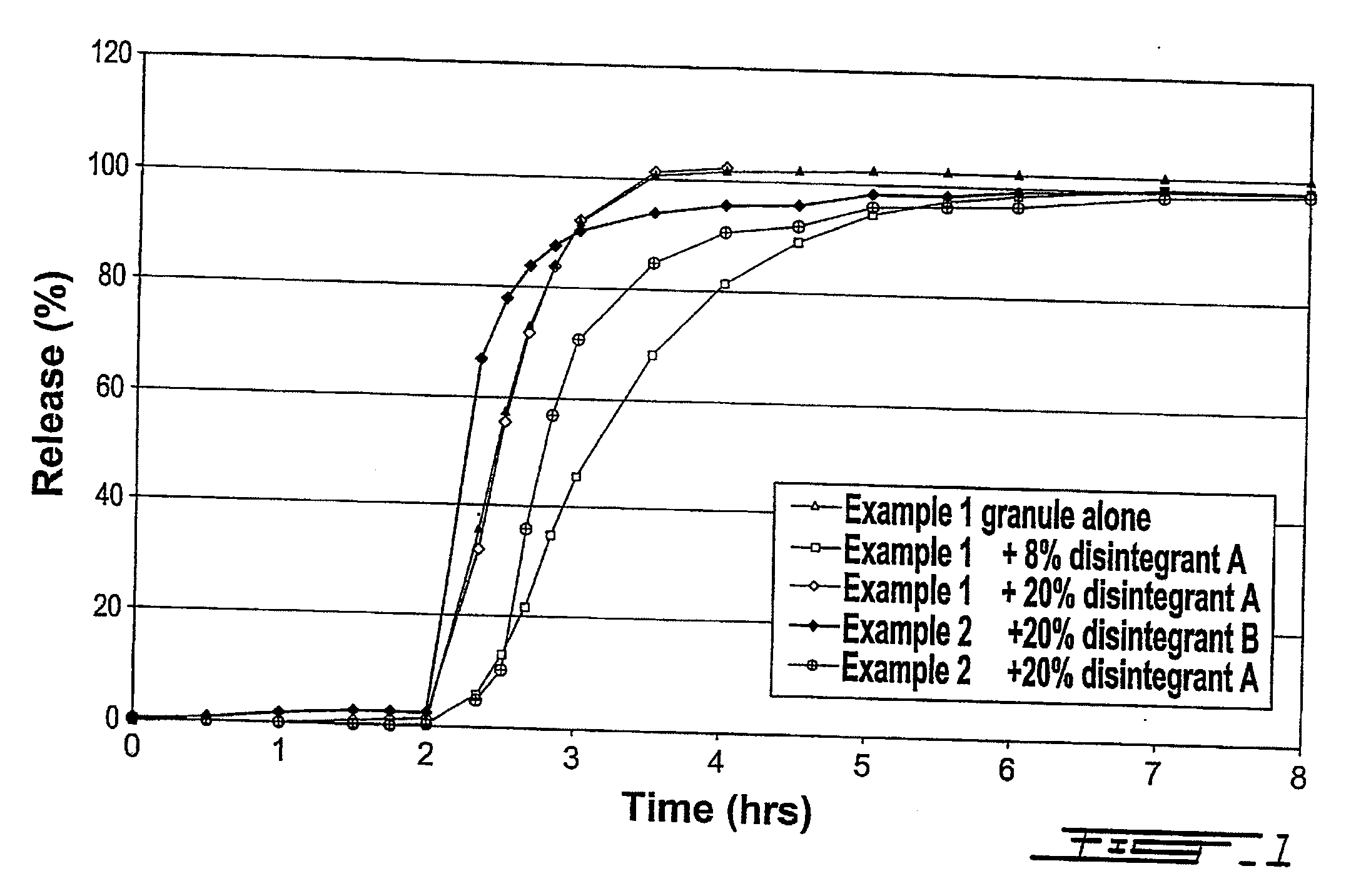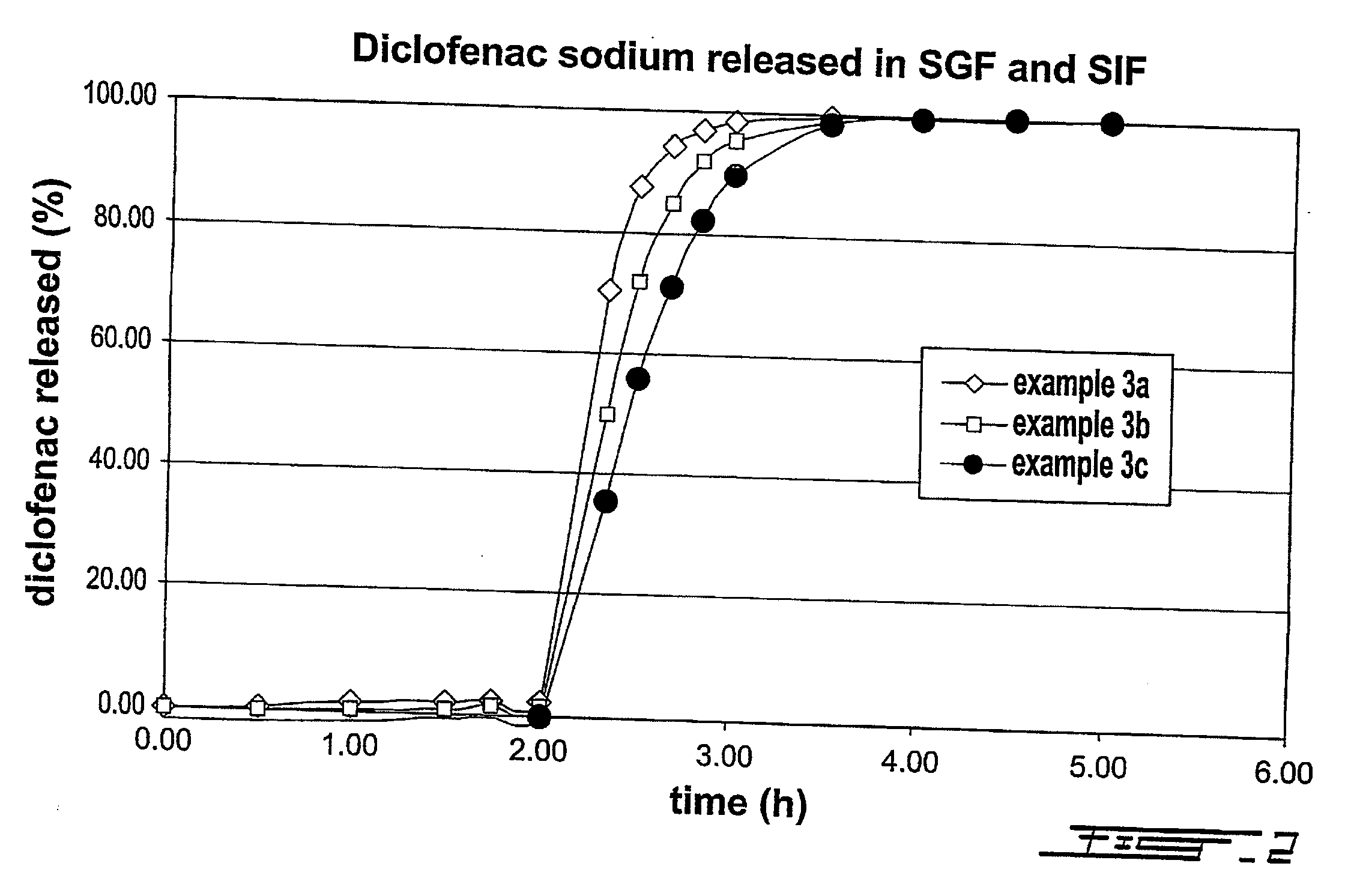Delayed release pharmaceutical oral dosage form and method of making same
a technology of delayed release and oral dosage form, which is applied in the directions of pharmaceutical non-active ingredients, pill delivery, oil/fat/waxes non-active ingredients, etc., and can solve the problems of less effectiveness, irritate the stomach, and increase the cost of use of enteric coatings
- Summary
- Abstract
- Description
- Claims
- Application Information
AI Technical Summary
Benefits of technology
Problems solved by technology
Method used
Image
Examples
example 1
[0075]The active ingredient (Diclofenac Sodium) and the pH-dependent polymer were placed in a jacketed bowl and mixed for homogenisation. The granulation liquid was obtained by heating the fatty alcohol at 55° C. The granulating liquid was incorporated into the mixed powders and the granulation process was continued until granulation occurred. The granulated material was then transferred to a metal tray, and cooled to 22-24° C. An appropriate grinder was then used to mill the granulated material. The milled material was then successively screened through a 2 mm and a 0.850 mm screen. The granules were mixed with an appropriate amount of disintegrant and the resultant composition was compressed into tablets of 625 mg weight having a diameter of 8.5 mm using a single punch press. The final formulation expressed as weight percentages contained 70% disintegrant and 30% of granulates (composition breakdown: 12% active, 15% fatty alcohol and 3% methacrylic polymer). The tablets were then ...
example 2
[0077]The fatty alcohol was melted and preliminary mixed with a methacrylic copolymer under vigorous stirring to obtain a homogeneous dispersion.
[0078]The Diclofenac Sodium was placed in a jacketed bowl and the dispersion was added gradually, under continuous stirring, until granulation occurred. The granulated material was then transferred to a metal tray, and cooled to 22-24° C. An appropriate grinder was then used to mill the granulated material. The milled material was then successively screened through a 2 mm and a 0.85 mm screen. The granules were then mixed with an appropriate amount of disintegrant (representing 8 to 20% from the total mass of the diclofenac layer) and the resultant mixture was compressed into tablets. For this preparation, the diclofenac layer weight could vary from 215 to 250 mg.
[0079]Tablets of Example 2 were then subjected to dissolution testing in accordance with the procedure mentioned before [USP apparatus I, 200 rpm, 2h Simulated Gastric Fluid (SGF),...
example 3
[0082]The Diclofenac Sodium and a fraction of the pH-dependent polymer (30% from total quantity) were placed in a bowl and mixed for homogenisation. The fatty alcohol was dissolved in ethanol and the rest of the polymer (70%) was incorporated to obtain the granulation liquid.
[0083]The granulation process was conducted without heating jacket, using the mixer at 500 rpm and the chopper at 1200 rpm until granulation occurred. The agglomerates were then broken down by any suitable means to comminute oversize agglomerates and produce a mixture of powder and small particles preferably with a diameter under 0.85 mm. An appropriate amount of disintegrant was added and the resultant mixture was compressed into tablets.
[0084]The tablets of Example 3 were then subjected to three dissolution tests, Examples 3a, 3b and 3c, in accordance with the procedure mentioned in example 1.
[0085]The dissolution profiles 3a, 3b and 3c, shown in FIG. 2, indicate a modulation of opening times of diclofenac gra...
PUM
| Property | Measurement | Unit |
|---|---|---|
| diameter | aaaaa | aaaaa |
| diameter | aaaaa | aaaaa |
| temperature | aaaaa | aaaaa |
Abstract
Description
Claims
Application Information
 Login to View More
Login to View More - R&D
- Intellectual Property
- Life Sciences
- Materials
- Tech Scout
- Unparalleled Data Quality
- Higher Quality Content
- 60% Fewer Hallucinations
Browse by: Latest US Patents, China's latest patents, Technical Efficacy Thesaurus, Application Domain, Technology Topic, Popular Technical Reports.
© 2025 PatSnap. All rights reserved.Legal|Privacy policy|Modern Slavery Act Transparency Statement|Sitemap|About US| Contact US: help@patsnap.com


